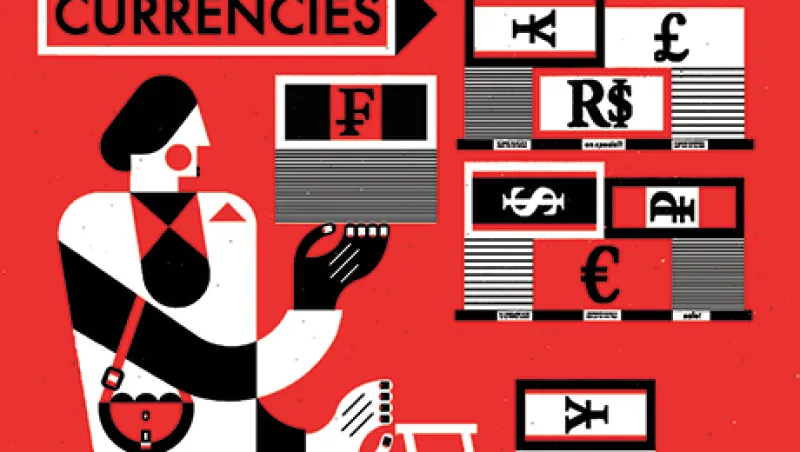Trading firms specializing in retail foreign exchange are facing tougher leverage limits and may come under increased scrutiny from regulators as a result of hundreds of millions of dollars in client losses after the Swiss franc’s dramatic surge on January 15. At least three forex trading firms went belly up after that episode, and a U.S. player required a bailout.
“The people who are in this market don’t have the same financial protections that apply to other investors,” says Sharon Bowen, a commissioner of the Commodity Futures Trading Commission (CFTC). “People making these kinds of bets are least able to afford the losses.“ Bowen believes retail forex trading should have the same protections as derivatives trading. The Dodd-Frank Wall Street Reform and Consumer Protection Act shifted most derivatives trading to regulated exchanges.
Retail forex had been enjoying healthy volume gains before the Swiss National Bank (SNB) yanked the 1.20 euro cap from the Swiss franc and sent the currency rocketing up 39 percent. According to Boston-based research firm Aite Group, the retail forex market has been growing steadily since 2007, when it registered about $132 billion in daily turnover. The company estimates that 2014 total daily turnover had mushroomed to $413 billion, a significant gain though still a relatively small part of the overall forex market’s $5.5 trillion daily turnover.
The largest portion of the retail market is in Japan, where Aite Group estimates investors trade an average of $145 billion a day, about 35 percent of daily turnover, thanks to the Bank of Japan’s quantitative easing program and Prime Minister Shinzo Abe’s economic policies, which have driven the value of the yen down against the U.S. dollar and other currencies. Japanese retail investors have a long history of foreign currency carry trades in which they use low-yielding yen to buy foreign investments with higher yields.
“The retail market is driven largely by volatility, plain and simple,” says Javier Paz, an Aite Group analyst. “Frequent movements in prices when they start to trend or break out are typically triggers for increased retail activity.”
Unlike institutional forex sales, which are still mainly conducted over telephones with bankers, retail sales are almost exclusively transacted online.
According to a 2014 study by Bapi Maitra, global head of forex bank sales at Citigroup, there are 4 million retail traders globally, predominantly male with an average age of 35. The largest group on broker websites hails from Europe, which has 35 percent of the market by number of users, followed by Asia, with 24 percent, 13 percent in the Middle East and 8 percent in the U.S. According to Citigroup, the average retail forex account is just $6,600.
The SNB crisis has driven up prime brokerage costs, which affects institutional investors that use currency markets. At the same time, activities of smaller brokers dealing in certain forex pairs have been curtailed. “Retail FX volume is a key component to the vitality of the $2 trillion-a-day spot FX market,” says Aite Group’s Paz. “Consequently, we are revising lower our 2015 spot FX estimate by 3 percent due to lower retail FX market [volumes].”
One reason figures for customers on American websites are small is that the U.S. has the tightest regulation of retail forex trading in the world, limiting the amount of leverage investors can use to 50-to-1, meaning a $100 investment can buy $5,000 of bets. Meanwhile, investors in the U.K. or New Zealand can invest with 200-to-1 leverage. Since there are no limitations on Americans using foreign websites, which often accept deposits by credit card, U.S. retail investors often place their bets overseas.
One of the conundrums of retail forex has been its rising popularity despite evidence that most investors lose money. According to ForexMagnates, a website that collates broker reports from the National Futures Association, a retail forex regulator, only 35 percent of investor accounts turned a profit in the fourth quarter of 2014. Even though the same money-losing pattern has prevailed for years, a poll cited by Citigroup said that 84 percent of retail investors think they can make money.
If losing money isn’t enough to deter investors, last November six big banks — Bank of America, Citigroup, HSBC, JPMorgan Chase, Royal Bank of Scotland and UBS — were fined a total of $4 billion for a “free-for-all culture” that led to price rigging in currency markets, raising fears that the market might be artificially fixed.
According to Citigroup, 85 percent of the global retail trade comes through just ten brokers, which have more clout with banks because of their size. There are two principal types of retail brokers: principal and agency. Principal brokers take the other side of a customer trade and assume risk, while agency brokers pass trades to a liquidity provider, usually a bank serving as a prime broker, and ostensibly take little risk. But that assumption proved staggeringly wrong during the Swiss franc crisis.
Few retail platforms factored in the possibility of such a huge move in one currency on a single day. Many retail investors who had bet that the euro or yen would move higher against the Swiss franc had taken out a form of insurance called a stop-loss order, which should have limited losses if the Swiss franc moved against them by more than a few basis points. Instead, when the franc soared in the largest single currency move since 1971, there was no liquidity and no buyers to execute trades at stop-loss points, and client accounts went into free fall.
FXCM, the No. 2 retail brokerage in the U.S., said 3,000 customers had $1 billion in open positions that were long the euro against the Swiss franc when the SNB acted, but the firm had only $80 million in collateral in customer accounts. As a result, the company found itself with $225 million in “negative equity balances” with its prime brokers, Citigroup and Deutsche Bank. FXCM admitted it “may be in breach of some regulatory capital requirements” and borrowed $300 million from Leucadia National Corp. at a stunning 10 percent annual interest rate for two years.
FXCM was not alone. At least three other retail traders plunged into insolvency during the crisis: Alpari UK, a subsidiary of a Moscow-based firm; Global Brokers NZ, a New Zealand forex dealer; and a U.K. firm called Boston Prime. Among the big banks, Citigroup reportedly lost $150 million and Deutsche Bank $100 million. Neither bank confirmed the losses.
Saxo Bank, a Danish firm that had offered attractive leverage to retail customers, reported that it lost $107 million in leveraged client accounts during the Swiss franc move. The bank earned $240 million in profit in the first half of 2014, according to its annual report. Saxo is demanding that its clients repay their losses, says Kasper Elbjorn, Saxo’s head of communications. For its part, FXCM forgave 90 percent of client losses. Most retail brokers have forgiven clients with negative account balances.
How is it possible that so many retail brokers, with sophisticated risk management systems, could lose so much? Aite’s Paz says risk management failed to anticipate such a major move. For those companies using the agency model, like FXCM, “you’ve got a lot of people stampeding through the door saying, ‘I want to get out of my position,’” he says. But then the prime brokers, who were on the other side of the trades, “refused to provide liquidity to companies at advantageous prices for what the client needed.” Officials at FXCM turned down requests for comment.
The damage was much smaller at principal brokers. Toronto-based Courtney Gibson, head of trading and quantitative analytics at Oanda Corp., says his currency firm takes a more conservative approach to leverage than others, offering a maximum 50-to-1 anywhere in the world, and less in some places, such as Japan, where it’s 25-to-1. Oanda has also invested heavily in technology so that its risk management is more robust, Gibson says.
Because Oanda uses the principal approach, it was able to settle client trades internally, offsetting a sell order against an outstanding buy, rather than turning all trades over to third parties to be settled. As a result it had to go to the forex market relatively few times, he says. While it lost money, losses were minor compared to those of other firms. Oanda told clients that even though liquidity providers had changed quotes because of the Swiss franc move, it would honor its trades and not “requote” prices as other brokers were doing. It also forgave clients with negative account balances. Gibson says the number of new clients surged 50 percent in January, with most fleeing other firms.
Clients at other firms were not so lucky. “It’s like I’m living in FX bizarro world,” one investor complained in an online chat room after his stop-loss orders were ignored. “I will dedicate every day of my life until (the broker) returns what was stolen from me.”
Interestingly, even though many investors lost money in the crisis, retail volumes have not fallen sharply. Saxo Bank reported that average daily trading volume in February was $13.2 billion, down marginally from $13.8 billion in January. But client collateral on deposit at Saxo increased by $560 million to $8.6 billion, indicating little loss of investor interest. Saxo was among the banks raising collateral requirements.
The most significant fallout from the crisis was a rush of efforts to lower retail leverage. The National Futures Association imposed a 20-to-1 limit on leverage for Swiss franc investments; 33-to-1 for Swedish krona, Norwegian krone, Japanese yen and Australian dollars; 16-to-1 for the Mexican peso; 11-to-1 for the Brazilian real; and 5-to-1 for the Russian ruble.
At the same time, dealers such as FXCM and Saxo lifted margin requirements on some currency pairs. “Volatility is rising, and to reflect the potential increase in risk and to protect clients, banks and brokerages have to raise their margin, the sooner the better,” Saxo Bank’s chief financial officer, Steen Blaafalk, said in an online Q&A.
The losses suffered by retail customers are also likely to result in renewed efforts by regulators to rein in what some see as rank speculation by those who may be least able to afford losses.
Bart Chilton, a former CFTC commissioner, says he believes customer accounts should be protected with mandatory insurance in cases where firms go bankrupt, such as the $890 million loss in customer funds at MF Global in 2011, or at U.S. retail firms that commingle investment funds.
Bowen, Chilton’s Democratic successor at the CFTC, says a market in which two thirds of investors lose money on a net basis is not a good model. “At a minimum there should be the same level of regulation as the whole investment industry,” she says, citing rules covering execution and transparency as well as capital requirements. “Why this segment of the industry should be unregulated doesn’t make sense.”
Bowen says extreme leverage available on foreign platforms is her main concern. “Basically, you can’t have a race to the bottom, which this has become,” she says. “Risks that happen outside our shores can flow back.” She expresses satisfaction that firms are now being forced to reduce leverage, adding that with currency markets unstable, no one knows when other major moves might occur.
Executives at retail firms, such as FXCM CEO Drew Niv, have stated their opposition to reducing leverage on the grounds that investors would head overseas. But recent losses may have convinced all but the most speculative investors that a more conservative approach may be the wisest. •






